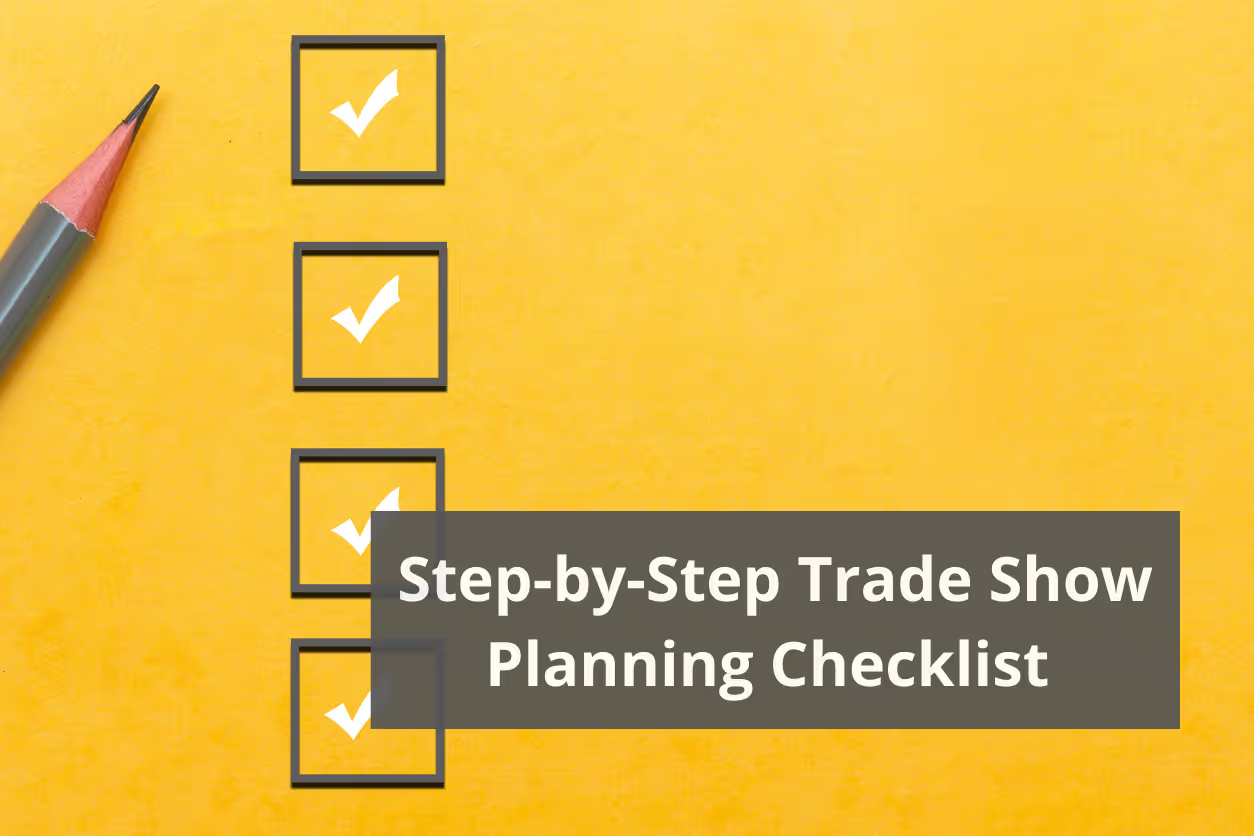Trade shows are kind of a combination of a face-to-face LinkedIn mixed with an in-person Amazon. Roughly 81% or 4 out of 5 attendees have buying authority at their company (CEIR, iCapture). With only a few days at most events, you must make a great impression quickly to maximize your return on investment (ROI). While a great booth won’t sell your product or build new relationships alone, it will provide the needed presence to attract new customers and give your staff the opportunity to do more business. Think of your trade show booth as an extension of your website, store, or office. It should be consistent, thought out, and professional.
We won't spend a lot of time explaining the importance of having a nice booth, most people understand the need. Generally, the bigger question is “where do we start”? A lot of companies have either never exhibited before or need to update their booth from an old one that was purchased years ago. There are several questions companies need to consider before they begin shopping for a new booth. Below are key questions to help guide you when beginning to look for a new trade show display.
Key Questions To Ask Your Team Before Shopping For A Trade Show Display
1. What do you want to achieve with this booth?
- Merchandising And Product Sales
If you’re trying to sell merchandise at the event, you may want a little bigger space with a floor plan that allows people to move freely from shelves or racks in different locations in the booth.

.avif)

- Brand Awareness
If you’re wanting to boost brand awareness with your display, you may be able to use a smaller booth with large singular logo graphics to achieve your goal. Backlit displays s are also a great option for branding.
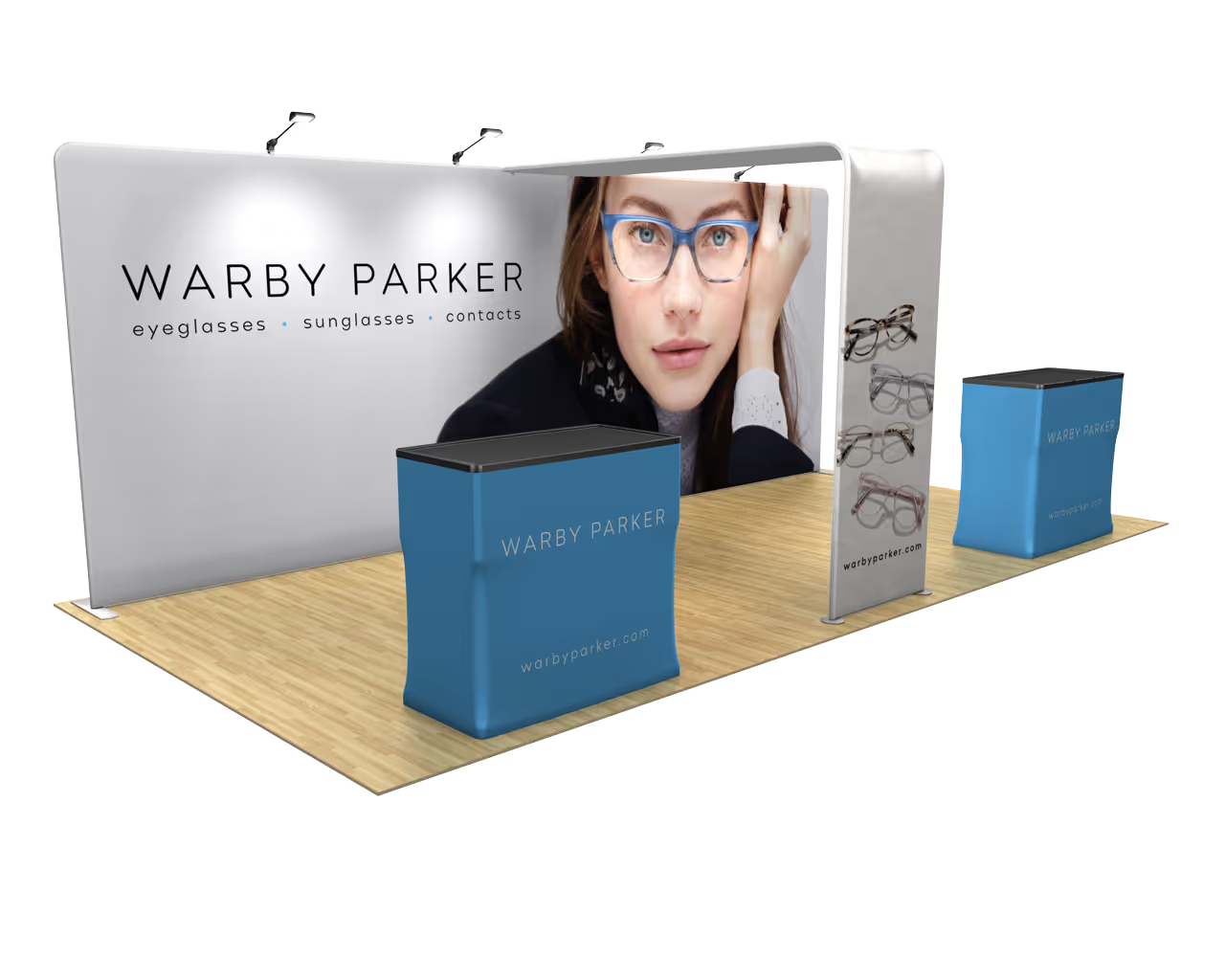

- Complex Products or Services
If you have an in-depth product or service like software or something that requires a service contract, you may want to rent a larger space and design your display to use branded panels on the exterior that also create private meeting rooms within the booth.


2. How Often will we use this booth?
- One Big Show Per Year
If your company will only use a large booth one or two times a year, you may want to review renting options or consider ordering a larger booth like a 10x20 or 20x20 display kit to maximize your appearance at limited shows.
- Regular or Semi-Regular Usage
If you need an exhibit that your company will use regularly or semi-regularly, you may want to look at a booth that is a little more lightweight, easy to assemble without show services, and less expensive to ship. Backlit displays like the Wavelight and Infinity DNA Kits are great options for an attention grabbing booth that fits this mold. Waveline, Waveline Media, and Exhibitline displays are also very popular for this usage.
3. Who will use the display?
- Veteran Trade Show Team
If you have a team of savvy trade show veterans, then you can feel pretty comfortable ordering any style of display from a 10x10 XVLine to 20x20 Kits and more. This team will be comfortable assembling the display kit quickly under the show deadline and know when to order show services to help with assembly. They will also know how to repack the booth when the event is over.
- Numerous Representatives
If you have several field sales representatives that will share a display and ship the booth around the country to each other, it may make more sense to get a lighter weight display like the Waveline Media 10.09 Kit that is less involved to assemble with one or two people and less pieces to repack at the end of the event.
- One Person Per Show
If you only have one person per show using setting up and using a display, make sure to ask your trade show booth provider for single person assembly instructions. This will let you know that the booth can be set up with one person and roughly how long it should take.
4. Where will you store the display?
- Warehouse
If you have access to warehouse space that you can store your trade show display, then this is not a limiting factor for your team. Rental storage space for your trade show exhibit is also available.
- Office / Person Residence
If you need to store the booth at your office or maybe in an employee's garage, knowing the shipping case specs and how many cases are involved is important to think about before ordering your booth.
5. Who will do the design work for the booth?
- In-House Designer
If your company has an in-house graphic designer who will handle the design aspect of your booth, that's great. You just need to be sure you provide them the graphic guidelines and templates for your specific booth layout. Also, make sure your trade show booth provider double-checks the art for possible problem areas. Designing for a large scale print can be a little tricky if your designer doesn’t design for that regularly.
- Agency
If you use an agency for your design work, they should be able to handle creating this art, no problem. Again, just be sure they have all the needed guidelines and templates for your booth and that your chosen booth provider double-checks all the art. We also recommend someone from your company be the person that gives final approval before the display is printed. Leaving the final approval up to a third party design agency can lead to communication errors.

- Trade Show Booth Producer
Many trade show booth sellers offer graphic design services. Some companies charge by the hour for design which is typically between the $25-$50 dollar an hour. Some companies, like us (MODdisplays) charge a flat fee to use our in-house design team. Our flat rate is $250 for any sized order where graphic assistance is requested. Other companies will charge tiered rates starting at around $100 for small projects and going above $500 for larger booths.
- Freelance Designer
Freelance designers are typically fine to use. We recommend looking for someone who has designed for large scale printing in the past, if possible. Freelance designers usually charge around $30-$100 per hour for their services. Again, be sure someone from your company is signing off on the final art approval to avoid communication mistakes.
- Yourself
Unless you have graphic design experience, we don't recommend using this option. Your design and booth layout is very important to maximizing your trade show return on investment. Don’t try to save a couple dollars on design. Work with professionals to get professional results.
6. How much should I spend on a booth? (How will I pay?)
Nobody can fully answer this question for you. How much you want to spend on events, exhibits, staffing, lodging, etc. will depend on a lot of internal factors. What we can do is provide some standardized benchmarks and guidelines to help you develop a plan. See this “How to Create a Trade Show Budget” blog post. It’s a quick read and you’ll find a lot of helpful information.
Keep in mind that in most cases, the kits and prices you see on a trade show display website can be altered by adding or removing certain elements. These kits are here to provide you with ideas but they’re not set in stone. If you see a booth style you like, set up a meeting to discuss options and find out how you can tailor the display down to what you want and need. You’ll be surprised at what you can build.
7. Who will be the project manager?
Pick a project manager for your order and let them be the contact person for your company. Having multiple contacts providing ideas, approval, shipping addresses, timelines, and feedback often leads to communication problems. It’s fine to have multiple people from your team involved, but choose a single project manager for your order and work through them.

8. What technology will we use in the booth?
- Monitors/Projectors
- iPads/Computers
- Lead Collection/Retrieval Software
- Industry Specific Technology
These are questions you need to ask before shopping for your display. If you need or want technology in your booth, work with your trade show display distributor to fit it in correctly.
9. What other items need to be in the booth?
Are you a golf club retailer and want to include a putting green in your booth? Do you want to have games in your space? If there is something that needs to be in your booth besides the display itself, like a game or marketing tool, let your display distributor know so they can help you plan a workable layout.
10. What colors do we want to use in the design?
This seems like an obvious question but knowing what exact colors you need it essential to creating the right look. If your company uses specific Pantone colors in your branding, you need to provide that information to your designer. If your brand doesn't currently use Pantones, we recommend selecting Pantone colors before having your design created. Using Pantone colors will help print teams provide a more consistent color match across different media and on future prints. It's also important to have general understanding of the differences between CMYK and Pantone colors and how different design elements like layers and gradients will impact the color of your display.
11. Will we want to expand this booth down the road?
If you're ordering a 10x10 booth today, consider the idea that you may need or what to expand that booth to a 10x20 or more at some point. Discuss this possibility and potential timeline with your team. When you start looking at booth styles, find out what their expansion capabilities are. Also, find out if you can be printed double-sided or break down into smaller sections that your team could possibly use in a lobby, hallway, store front, office, etc. The more versatile the display is, the more value it offers your company.


The above section is a quick overview of what you should ask your team before starting to search for your next exhibit. The next section are questions you should ask your trade show booth distributor.
Key Questions To Ask Your Trade Show Booth Provider Before Ordering
1. What is your process?
At the very beginning, ask for an overview of your display distributor’s process. This will help you understand what their steps are and what is expected of your team throughout the process. This seems obvious but it's worth asking to make sure both party’s expectations align.
2. What are the payment terms and options?
Be sure you understand when, how, and how much you need to pay from the beginning. Don't assume every company offers the same payment terms and options as your company. You never want to get to the end of an order and realize that you need to scramble for a credit card payment instead of sending the check you had planned on.

3. Do you provide 3D renderings?
3D renderings help you visualize how your booth will look when it's completed. This tool is very helpful for your team to ensure you are getting what you want without being able to physically touch it.
4. What is the turnaround time?
Before you order a display, make sure you ask for a timeline showing production and shipping times. Ask your trade show display provider to email you a timeline with graphic, payment, and delivery deadlines and clearly define what will happen if either side misses their deadline. This is a good way to organize your timeline and ensure everyone is on the same page.
5. Can you confirm the shipping address and tracking information?
Don't be afraid to ask your display contact to confirm the shipping address before you provide payment. Also confirm when you will receive the tracking information for your order. Once you receive the tracking information, be sure to keep up with it.
6. What are the shipping dimensions and weight for my order?
You need to calculate shipping costs into your event marketing. Ask for the dimensions, weight, and number of cases or boxes your order uses. Knowing this information will help you plan transportation and holding costs. Be sure to ask this question early as you begin building your booth.
7. How much electricity will my booth need?
Regardless of whether you have two lights or 10 full backlit displays, ask how much electricity your booth requires. This information is important when ordering what you need from the exhibit hall. If you have ordered products that require electricity from another source, be sure to include that with your booth information.
8. Can you provide a flame retardant from for this display?
This is a standard form all display distributors should have quick access too. Many shows will ask you to provide this form so being sure you have it from the beginning can save you time in the end.
Knowing what your team wants and developing a strong relationship with your display provider is essential in creating a professional exhibit. We also recommend that you reach out and talk with your show coordinator to about any potential restrictions. Here are four questions to ask.
Key Questions To Ask Your Show Coordinator
1. What are the display height restrictions for my booth space?
Most exhibit halls and show venues will have specific height restrictions for each space size. For example, a 10x10 space may have an 8ft height restriction in the back half of the booth and 4ft height restriction in the front. This means your displays cannot be higher than those restrictions or you could be forced to take down your booth. In most cases these restrictions will be listed in a welcome packet for exhibitors or on the show website itself but if you don’t see it, find out if you have any restrictions before planning your booth
2. What are the delivery dates and addresses for the show?
Nearly all large venues like the Las Vegas Convention Center, The Javits Center, and the Orange County Convention Center will work with management companies like Freeman or GES to offer advanced warehousing and storage options for their events. This means you can ship your display to the advanced warehouse several days or weeks before the event and they will hold it for you and deliver it to your show site on setup day. Shows also have dates and addresses where you can have your booth shipped directly to the show site. You must know the dates and times when the advanced warehouse is accepting packages and when you need to ship it directly to the event. It's common different elements of your booth will ship in several different shipments and from different locations. Knowing when and where your items need to be delivered will save you on shipping upgrades, warehouse fees, and help avoid lost packages.
3. Where do I get my show labels?
Most shows provide shipping labels that need to be used for the warehouse or show site in your exhibitor’s welcome packet. If you have the shipping labels, be sure to provide them to your trade show distributor. If you don’t see them right away, reach out to your show contact and ask how you can receive these labels.
4. What are the show labor costs?
If you think you will need to use show labor or are considering using show labor, be sure to ask for a quote or pricing sheet. We recommend doing this before deciding on what booth or space size to purchase.
Now that you have a roadmap and know the questions you should be asking when ordering your new booth, there are a few basic terms you should know. This list of terms will help you understand what your booth provider, designer, and show coordinator are talking about.
Design Terms and Concepts

1. Pantone vs CMYK colors
Pantone colors refer to the Pantone Matching System (PMS) that is a standardized color matching system created by Pantone Inc. This system uses specific color numbers, color names, and color swatches to ensure a consistent color match. CMYK stands for Cyan, Magenta, Yellow, and Black. When printing with CMYK, these four colors will be combined and layered to make all other colors and images in the CMYK artwork.
There are a lot of technical complexities involved in color matching and we can't go over all of them in this post. Instead, we will just touch on the main point that impacts you the most. If you need a specific color(s) in your design, you will need to provide the designer with the Pantone color number(s) you want used for that color. Pantone colors are standardized colors that make color matching much easier for print teams. You can find Pantone color using a Pantone color swatch found at many art stores and on Pantone’s website. If your company has not yet identified Pantone colors for your brand, we recommend you do that before printing anything. Also, check out this blog post explaining CMYK vs Pantone colors in easy to understand terms.
2. High Resolution Images
Large scale images like displays must use high resolution artwork. Every design team is different but we recommend using art that is over 72 DPI.
3. Vector vs Raster Artwork
Check out this quick post for a good summary of what you need to know.
4. Hard Proof
You need to know that hard proofs are available for most graphic displays if you request them. These are generally small (roughly 11”x18”) samples you can order from the print team. The purpose of these samples is so that you can see exactly how specific colors or art sections will look when they are printed on the same material your actual display will be printed on. A hard proof can save you a lot of money and give you peace of mind if you have any concern how a color or art element will print.
Booth Terms And Concepts
1. 10x10 doesn't mean it's a 10x10 display
When you see display sizes like 10x10 or 20x20 you need to know that size refers to the booth space that display is designed to fit in, not the display size itself. For example, most 10x10 displays are just under 10ft wide and roughly 8ft tall.
2. Booth space configurations
- Inline Booth
This is the most standard booth configuration with one side facing an aisle

- Corner Booth
Less common booth with two sides facing an aisle. These can work really well if you're trying to sell merchandise and are wanting to increase foot traffic through the booth.

- Peninsula Booth
These spaces have three sides facing an aisle. Great for opening up booth traffic and adding items like welcome desks, kiosks, and monitors stands to the open edges of the booth.

- Island Booth
These are commonly 20x20 and larger booths with all four sides facing an aisle. These spaces open up all kinds of layout and traffic flow possibilities.

3. Standard Display Styles

- Tension Fabric Displays
Waveline, Waveline Media, and Waveline Banner Stand displays are our most popular tension fabric options. These consist of aluminum poles that snap together to create a sturdy and lightweight frame. Pillowcase style fabric graphics slip over the frame to create a snug fit and an easy to assemble display.

- Modular Displays
These display systems are a little more heavy duty, generally utilizing a metal extrusion based frame. with Silicone Edge Graphics (SEG) fabric and infill panel graphics. A good example of this display style would be our Exhibitline and XVline kits.

- Banner Stand Displays
You may have heard these displays called Pop Up Banners, Roll Up Banners, Easy Up displays, Banner Screens, etc. Regardless, they are all the same thing. These displays are generally vinyl graphics that retract up from a metal base and held in place with a thin pole. See our Penta banner stand for an example.

- Backlit Displays
The name says it all. Displays like the Infinity DNA and the Wavelight use small LED lights to illuminate your graphic. These displays are great value as they are lightweight, affordable, easy to assemble and great at grabbing attention.

- Tabletop Displays
If you are doing a small expo or conference, these displays can be a great option. Easy to carry and assemble while still offering a professional look. Tabletop displays can also make a nice backdrop for virtual chats.
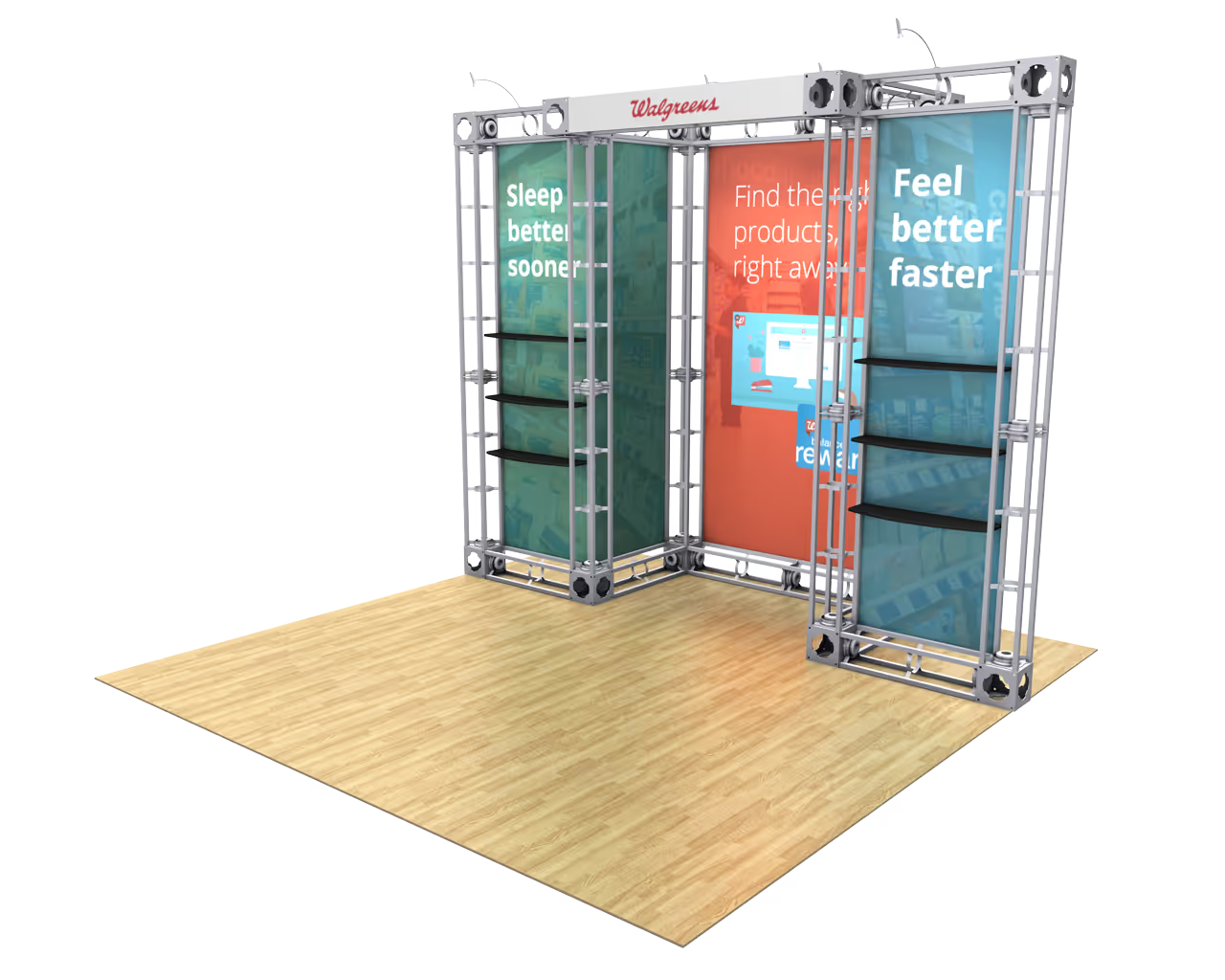
- Truss Displays
Think of a giant erector set and you will get the basic premise of a Truss display. These booths tend to have an industrial look that fit well with many companies and industries. Truss displays are more heavy duty than most and large display kits generally require show labor to assemble and break down.
For more information, ideas, and images on display configurations, take a look at this helpful post.
4. Step-And-Repeat
This is a backdrop that repeats either one or more logos across the entire display. These are generally used as backgrounds for interviews, video chats, or press conferences. Step-And-Repeat displays are displays that almost every company will benefit at some point from having.


5. Case-To-Counter
When you see this term it means that the hard shipping case actually doubles as a counter for your booth. View the CA700 and CA500 shipping cases to see what we mean.
Now that you know some of the general terms and concepts, let's look at some do’s and don’ts when it comes to ordering and exhibiting.
Do’s and Don’ts
1. Don't wait until last minute to order
We know sometimes this is unavoidable and sometimes it's not up to you alone to make the final decision. Ordering a booth last minute leads to rushed decisions, rushed production, rushed shipping, and increased costs. It also leads to more errors and room for problems. We recommend taking some time at the start of the year to sit down and map out the shows you plan to attend that year. Then send that list to your display distributor and let them help keep you on track with initial display and design ideas. Ask them to follow-up with you a month before each show to kick start your planning.
2. Do assemble your booth before your event
If possible, have your booth shipped to you before the event so you can take a dry run setting it up. Most displays are not hard to assemble but if you’re doing it for the first time on setup day at the event, under pressure, the experience can be much tougher.
3. Don't make your design busy
Your display doesn’t sell your product or service, you do. The goal of your design should be to make your booth inviting, clearly identify who you are, and give a quick visual hint to what you do. Adding a lot of text explaining who you are, what you do, and why they should work with you will almost never be read because it’s overwhelming to your guests. Remember that your display is a storefront, not a white paper. This post can help to create an attention grabbing design.
4. Do be social
Tweet, post, snap, upload, and go live! Share your show experience on social media as it's happening. Show behind the scenes pictures of your team getting Starbucks and Red Bulls before the event starts. Let your followers see your team assembling the booth. Send daily updates of what you're doing and seeing at the show. Set aside a little time everyday to make a video or go live from your booth to answer questions or discuss things your followers may care about. Just because a potential contact isn't at the event, doesn't mean they can’t “visit” your booth. Be social and don't waste this great content. Shows aren’t cheap, maximize your ROI every way you can.
5. Don't be Frankenstein
Trying to save a few dollars with a DIY booth may help upfront but it will hurt more later as you will drastically limit your ROI potential. Remember, you're exhibiting at a professional event, not a yard sale. There are some many professional and affordable display options you should never limit your potential with a DIY display.
6. Do use Pantones
We touched on this before but it's worth saying again. If you have specific colors you want to use in your design, you should use Pantone colors. Using a Pantone color will ensure the best and most consistent color match now and in the future. Make life easier for yourself and pick Pantones for important brand colors.
7. Don't ignore using technology in your booth layout design
Using lead capture and retrieval tools like Zaunt or CVent can help your team drastically boost your show's return on investment. Just using monitors, iPads, and monitor stands to show videos, live feeds, or product demos can really increase engagement for a marginal cost.
8. Do use lights
Lighting impacts how you look and how your customers perceive you. Dim booths get less attention. This article does a good job explaining the value of trade show booth lighting in more detail. Lighting seems like a small part of the overall booth layout but it can make a big difference.
9. Don't forget about accessories
Exhibit accessories like Soft Wood Flooring make your booth look more polished and professional to guests while also making the booth much more comfortable to stand in for your staff. If you have a lot of giveaways or literature, use counters or brochure stands. Booth accessories are generally an affordable way to finish off your booth visually while maximizing your space and increasing your efficiency.
10. Do giveaway your monitor
A little trick we like to recommend is to use your monitor as a prize. Standard 40"- 43" monitors can be purchased pretty inexpensively online or at big box retailers. Instead of tossing the monitor or paying for a case and shipping charges to all your events, give it away as prize and save your team money and headaches with shipping. Anyone who provides their follow-up information will be entered to win. On the last day of the show, you randomly pick a winner and contact them to come pick up the monitor and box. Note that if you do have a specific monitor you want to keep, look at www.phillycase.com to build a custom shipping case for you.
The above lists and recommendations are meant to provide you with a base knowledge and help guide you through ordering a trade show booth. We hope this post can act as a cheat sheet for your company as you go through the exhibit ordering process. If you have any questions about this post or anything involving your trade show marketing, feel free to set up a meeting with our team, email info@moddisplays.com, or call us at 1.877.663.3976.





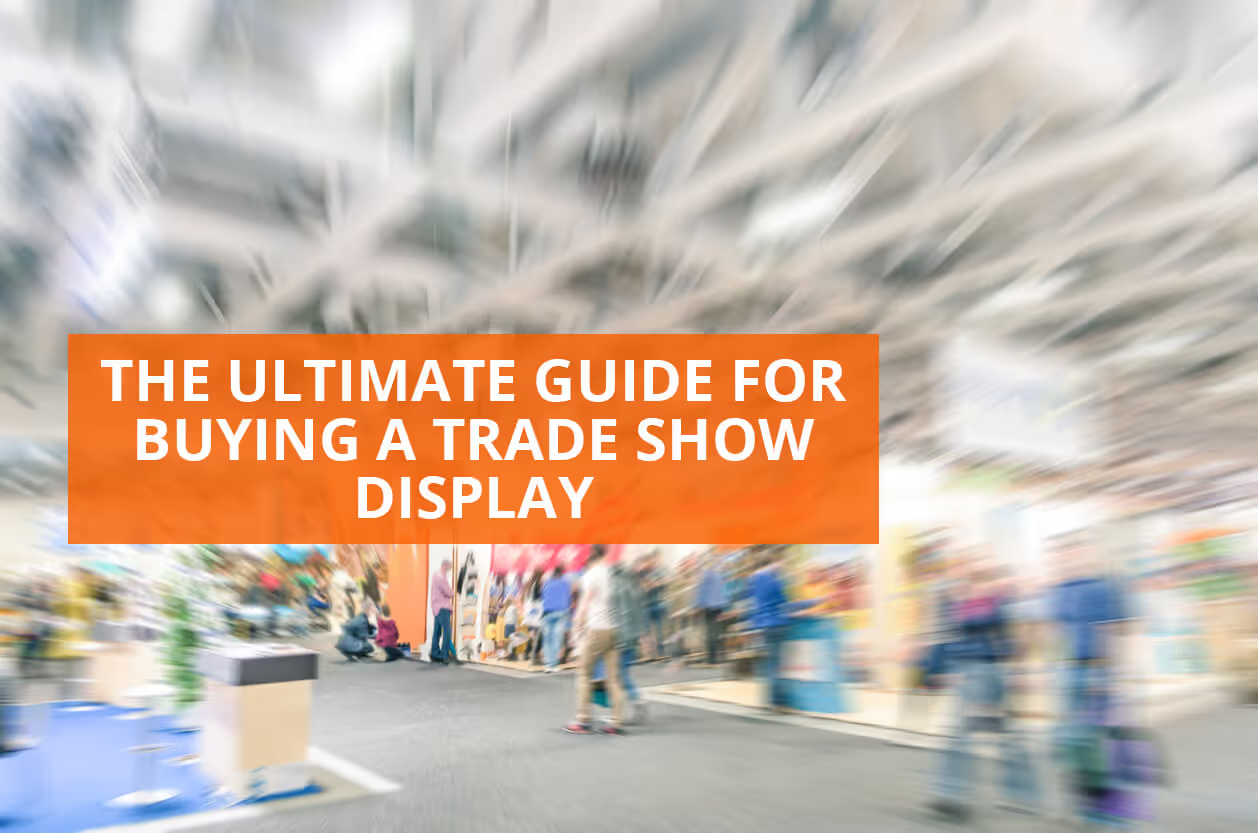
.jpg)
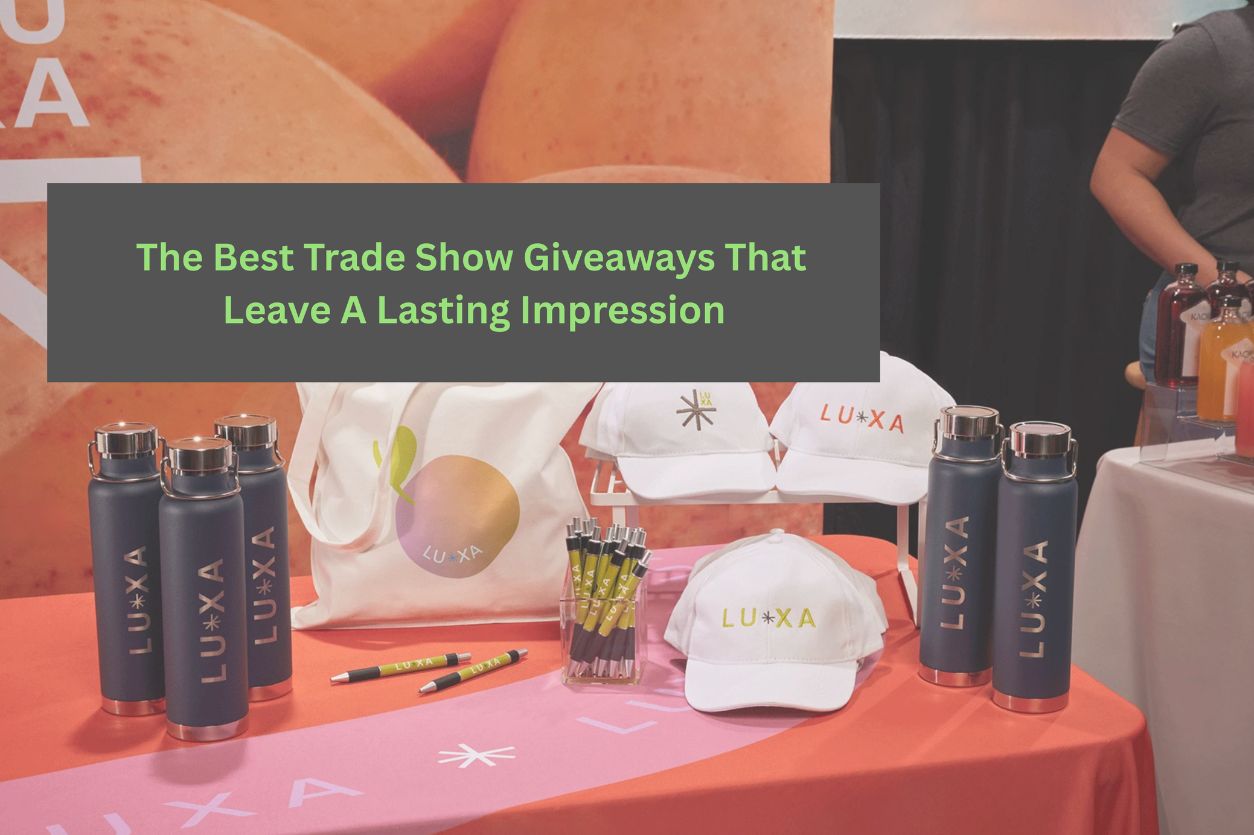
.png)

.avif)



